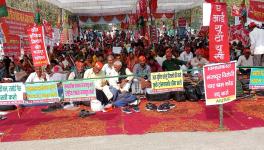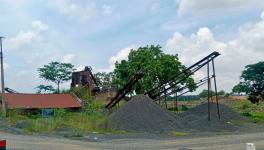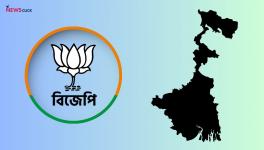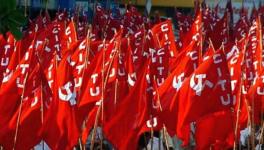Unaffected by COVID-19 so far, Odisha Kendu Leaf Workers Keep Fingers Crossed
Kolkata: Bharati Nayek and Chuna Nayekare kendu leaf (KL) pluckers attached to the Mohul Khola ‘phadi’ (godown) at the Sadar Range of Odisha’s Dhenkanal district. Both the women have been allotted KL plucker cards bearing nos. 51396 and 51416, respectively, by the Odisha forest department.
Kendu leaf is a forest produce used to make the outer layer of bidis. Bharati and Chuna are among lakhs of co-pluckers and other workers spread over 21 out of 30 districts of Odisha, which is the third largest producer of kendu leaves after Madhya Pradesh and Chhattisgarh, with an output of 4.5-5 lakh quintals a year.
So far this year, circumstances have turned out to be fortuitous and have worked in favour of pluckers like Bharati and Chuna, despite the country reeling under the severe impact of COVID-19. Both of them are, therefore, hopeful that the situation will continue to remain like it is up to mid-May and they continue to get liquid cash transferred to them under the direct benefit transfer (DBT), operated in this case by the State Bank of India under its ‘cash management products’ scheme.
So, how have the present circumstances not affected kendu leaf pluckers so far?
The answer lies in seasonality of the activity, Odisha’s principal chief conservator of forests (PCCF),PrabhakarBehera, told NewsClick from Cuttack.
Plucking kendu leaves is basically a three-and-a-half-month activity. February is utilised for bush cutting and that work was completed unhindered as at that time the deadly coronavirus or COVID-19 had not spread as far and wide as it has now, even though the first case was reported in January end.
A period of 45 days covering March up to mid-April traditionally marks the time for ‘green shoots to mature into the leaf phase.
March has seen the desired leaf growth phase, “giving us no reason for concern”,said Behera. And this explains why lakhs of KL workers are looking forward to undisturbed six weeks between April and mid-May, according to Jogendra Tripathy, general secretary of Odisha Kendupatra Karmachari Sangha, affiliated to the Hind Mazdoor Sabha, which has a dominant presence on the Odisha’s KL sector.
Workers are fervently hoping that the 45-day phase up to mid-May will not have an unsettling effect on their lives, Tripathy told NewsClick from Dhenkanal.
Plucking begins in mid-April and follow-up activity up to the pre-marketing stage of the leaves will be completed by mid-May. Plucking is done entirely by women, an overwhelming majority from the Scheduled Tribes.
The forest department’s responsibility ends with the handing over of the produce to the Odisha Forest Development Corporation (OFDC), which is tasked with the responsibility of marketing. OFDC, set up in 1962, happens to be the country’s first state-owned forest corporation.
According to Behera, the bulk of Odisha’s KL produce – as much as 80% -- from 17 out of 21 districts is processed in the sense that plucking is followed by drying, graded sorting, binding and depositing the bound produce to ‘phadis’. Only 20% of the produce, mainly from Koraput, Malkangiri, Nowrangpur, Rayagada and parts of Kalahandi districts, are of relatively inferior quality and are placed in ‘phal’(not processed) category. The produce of Bolangir district is much sought after by buyers who take part in OFDC’s marketing format.
At present, pluckers are paid Re 1per ‘kerry’ (bundle), which consists of 20 processed leaves. For ‘phal’ grade leaves, the rate is Rs2 per ‘kerry’ and here 40 leaves make a ‘kerry’.
Asked about the average earnings of a plucker in a season, Behera said it works out to about Rs 3,000+ and given that, a welfare component available to economically very weak sections of the population takes care of “their other requirements for existence to a reasonable extent”. The cash made available to them under DBT proves greatly useful to them. When off from the KL-related activity, these workers try to earn a livelihood by selling Sal seeds and leaves and Mohua flowers, said a source.
Odisha chief minister Naveen Patnaik has been clear that neither royalty nor even a part of the profit from the KL trade should go to the state exchequer, and gains from the operations to the last paisa should be spent for the welfare of the KL workers, whose number exceeds 8.5 lakh in the state.
In addition, there are 20,000 plus binders and 17,000 plus seasonal workers. A Kendu Leaf Development Fund is in place since 2014. It is a coincidence that despite fluctuations that mark most trading activity, this activity in Odisha continues to register profits; sometimes more, sometimes less, a source told NewsClick.
As ‘bidis’ are in the list of ‘sin’ items under the Goods and Services Tax (GST) and are taxed a high 28%, the demand for kendu leaves has weakened somewhat in recent times. The GST incidence was preceded with the sudden demonetisation decision of the Union government in early November 2016, which had marked the start of a somewhat difficult phase for the trade.
Trade union leader Tripathy said the welfare component for workers has within its purview schemes for assistance in case of untimely death and for medical treatment, education of sons and daughters, marriage of up to two daughters. Under all heads, assistance for women, daughters and girl child is higher than those earmarked for males.
In addition, an arrangement was worked out with Life Insurance Corporation of India under its Jana Shree Bima Yojana in late July in 2012. The premium was fixed at Rs 200 per person per year, 50%of which was to be borne by the state government and the balance was to be arranged from a Union government fund. The age eligibility for a beneficiary was set at between 18 and 59 years.
An overwhelming percentage of the KL workers in Odisha are unionised under the banner of OKKS, a tradition that goes, according to general secretary Tripathy, to the credit of Biswanath Pandit – a Kashmiri Pandit – and Sarangdhar Das, who became a member of LokSabha in 1957.
“Both were blessed with a pronounced socialist bent of mind and worked tirelessly to unionise the workers. Pandit had come down to Cuttack to visit his ‘biradari’, fell in love with the place and its surroundings and devoted his time and energy to the cause of workers. Their life and activity had influenced me to take the plunge in trade union activity”, Tripathy, now 78, told NewsClick.
The KL trade was nationalised in early January 1973 in the interest of orderly growth and freeing workers from exploitation by private contractors. This was the result of ajoint initiative taken by the then Odisha chief minister Nandini Satpathy and then Prime Minister Indira Gandhi. The regulatory features of the Act of 1961 were fine-tuned and strengthened in the nationalisation decision, demand for which had been intensifying for over a year by then.
Although the pluckers are paid with reference to one bundle of 20 processed leaves and 40 ’phal’ leaves, the trading is with reference to weight in kg/quintal.
However, despite welfare measures, there has been discontent over the payment criteria for the labour involved.
As per a preface to a 2006 report by New Delhi-based Human Development Society (HDS) and sponsored by National Human Rights Commission, a kendu leaf plucker is paid for the number of leaves on piece-rate basis. This, therefore, “is a payment not for labour but for the product”.
The HDS study also observed the presence of child labour in plucking activity. On the royalty issue, the report said : “Royalty received by the government is total sale value of the year minus advance amount paid to the KL wing of the forest department for working expenses, amount of sales-tax and commission of OFDC.”
This is one reason why on March 11, the union organised a road blockade at Sambalpur and other centres to protest, as union president Bijoy Mohanty told media, the state government’s decision to abolish 24 range offices, over 50 KL sections and around 500 ‘phadis’ which, if implemented, would leave a good number of people jobless. While the state government has attributed the move to the need for continued viability, the union has urged the state government not to proceed with the move in the interests of workers, most of whom are STs.
The writer is a Kolkata-based freelance journalist.
Get the latest reports & analysis with people's perspective on Protests, movements & deep analytical videos, discussions of the current affairs in your Telegram app. Subscribe to NewsClick's Telegram channel & get Real-Time updates on stories, as they get published on our website.
























